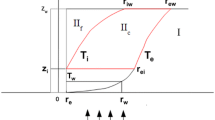Abstract
The combustion of ultrahigh molecular weight polyethylene (UHMWPE) in airflow perpendicular to the polyethylene surface (counterflow flame) was studied in detail. The burning rate of pressed samples of UHMWPE was measured. The structure of the UHMWPE–air counterflow flame was first determined by mass spectrometric sampling taking into account heavy products. The composition of the main pyrolysis products was investigated by mass spectrometry, and the composition of heavy hydrocarbons (C7—C25) in products sampled from the flame at a distance of 0.8 mm from the UHMWPE surface was analyzed by gas-liquid chromatography mass-spectrometry. The temperature and concentration profiles of eight species (N2, O2, CO2, CO, H2O, C3H6, C4H6, and C6H6) and a hypothetical species with an average molecular weight of 258.7 g/mol, which simulates more than 50 C7—C25 hydrocarbons were measured. The structure of the diffusion flame of the model mixture of decomposition products of UHMWPE in air counterflow was simulated using the OPPDIF code from the CHEMKIN II software package. The simulation results are in good agreement with experimental data on combustion of UHMWPE.
Similar content being viewed by others
References
H. F. Mark, N. M. Bikales, Ch. G. Overberger, and G. Mendes, Encyclopedia of Polymer Science and Technology (Wiley Interscience Publ., New York, 1986).
D. J. Holve and R. F. Sawyer, “Diffusion Controlled Combustion of Polymers,” Proc. Combust. Inst. 15, 351–361 (1975).
W. J. Pitz, N. J. Brown, and R. F. Sawyer, “The Structure of a Poly(ethylene) Opposed Flow Diffusion Flame,” in Proc. 18th Symp. (Int.) Combust. (1981), pp. 1871–1879.
W. J. Pitz, N. J. Brown, and R. F. Sawyer, “Flame Structure Measurement of Polymer Diffusion Flames,” in Proc. West. Stat. Sect. Combust. Inst (1979), LBNL Paper LBL-9567.
J. R. Richard, C. Vovelle, and R. Delbourgo, “Flammability and Combustion Properties of Polyolefinic Materials,” Proc. Combust. Inst. 15, 205–216 (1975).
Y. Ogami, M. Mori, K. Yoshinaga, and H. Kobayashi, “Experimental Study on Polymer Pyrolysis in High- Temperature Air Diluted by H2O and CO2 Using Stagnation-Point Flow,” Combust. Sci. Technol. 184, 735–749 (2012).
H. Tsuji, A. K. Gupta, T. Hasegawa, M. Katsuki, K. Kishimoto, and M. Morit, High Temperature Air Combustion: From Energy Conversion to Pollution Reduction (CRC Press, Boca Raton, 2003).
J. A. Onwudili, N. Insura, and P. T. Williams, “Composition of Products from the Pyrolysis of Polyethylene and Polystyrene in a Closed Batch Reactor: Effects of Temperature and Residence Time,” J. Anal. Appl. Pyrol. 86, 293–303 (2009).
N. Gascoin, G. Faua, and P. Gillard, “Experimental Flash Pyrolysis of High Density Polyethylene under Hybrid Propulsion Conditions,” J. Anal. Appl. Pyrol. 101, 45–52 (2013).
O. P. Korobeinichev, A. A. Paletsky, L. V. Kuibida, M. B. Gonchikzhapov, and I. K. Shundrina, “Reduction of Flammability of Ultrahigh-Molecular-Weight Polyethylene by Using Triphenyl Phosphate Additives,” Proc. Combust. Inst. 34, 2699–2706 (2013).
T. Ueno, E. Nakashima, and K. Takeda, “Quantitative Analysis of Random Scission and Chain-End Scission in the Thermal Degradation of Polyethylene,” Polym. Degrad. Stab. 95, 1862–1869 (2010).
C. Beyler and M. Hirschler, “Thermal Decomposition of Polymers,” in SFPE Handbook of Fire Protection Engineering, Ed. by P. J. DiNenno, 2001.
A. E. Lutz, R. J. Kee, J. F. Grcar, and F. M. Rupley, Chemkin Collection, Unlimited Release (Sandia National Laboratories, Livermore, 1997).
R. J. Kee, F. M. Rupley, and J. A. Miller, “CHEMKIN- II: A Fortran Chemical Kinetics Package for the Analysis of Gas Phase Chemical Kinetics,” Sandia National Laboratories Report No. SAND 89-8009B (Albuquerque, 1989).
H. Wang, X. You, V. Joshi, S. Davis, A. Laskin, F. Egolfopoulos, and C. Law, “USC Mech Version II. High-Temperature Combustion Reaction Model of H2/CO/C1—C4 Compounds,” in http://ignisuscedu/USC Mech IIhtm (May 2007).
Author information
Authors and Affiliations
Corresponding author
Additional information
Published in Fizika Goreniya i Vzryva, Vol. 52, No. 3, pp. 8–22, May–June, 2016.
Rights and permissions
About this article
Cite this article
Gonchikzhapov, M.B., Paletsky, A.A., Tereshchenko, A.G. et al. Structure of ultrahigh molecular weight polyethylene–air counterflow flame. Combust Explos Shock Waves 52, 260–272 (2016). https://doi.org/10.1134/S0010508216030023
Received:
Accepted:
Published:
Issue Date:
DOI: https://doi.org/10.1134/S0010508216030023




